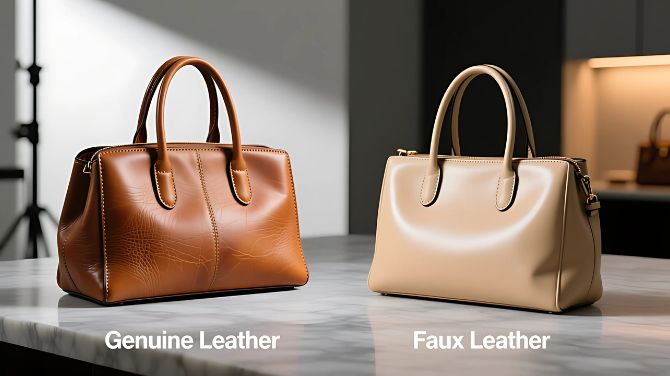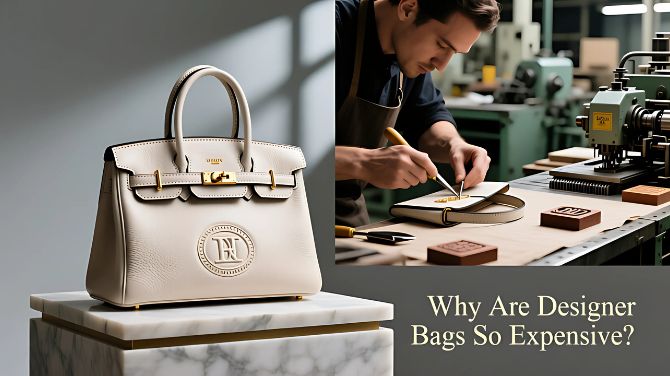Leather vs faux leather handbags fill shelves and screens everywhere. They promise style, durability, and value. However, doubts often arise quickly. Therefore, understanding leather vs faux leather handbag options clears confusion right away. You wonder which survives daily wear.
Which fades after one season? Which fits your routine perfectly? Meanwhile, trends in 2025 emphasize sustainable twists. For example, bio-based faux alternatives from apple waste or mycelium blend ethics with performance. Overall, informed choices prevent regrets entirely.
Handbags act as small investments and constant companions. Choose poorly, and replacements add up quickly. Select wisely, and it joins your trusted collection seamlessly. Let’s simplify the decision now. Skip the hype entirely. Focus on practical insights instead. Thus, empower your next purchase confidently.

Quick Promise: What You’ll Gain
By the end, gain clarity on leather vs faux leather handbag differences. Apply them immediately for smarter buys. Learn daily behaviors and long-term expectations with real examples. Master simple care routines that fit busy lives. Test bags in-store quickly to spot winners.
Match materials to lifestyles and budgets with concrete scenarios. Weigh sustainability and ethics using 2025 data. Explore repairs and resale to stretch dollars further. Plus, enjoy brief stories and preferences without filler.
All concise and actionable. For instance, discover how a $200 leather tote outlasts three $50 faux ones over years. Hence, save time and money effectively.
Start with a Simple Question
How do you use this handbag most days? Consider commuting with a laptop amid spills. Or tossing it on crowded trains during rush hour. Perhaps meetings demand neatness under fluorescent lights. Weekend markets bring dents and unexpected drizzles. Answer first to narrow options. Choices simplify dramatically.
Heavy-duty days prioritize durability and repairs above all. Low-fuss needs favor weather resistance without rituals. Faux shines there for quick wipes. Heirloom goals lean toward leather’s timeless appeal. One question yields big insights. Thus, personalize easily. Meanwhile, reflect on your week for accuracy.
Leather vs Faux Leather Handbag: Quick Comparison Table
See leather vs faux leather handbag differences at a glance. This table highlights key features. Updated for 2025 trends like bio-based durability gains in faux.
| Feature | Leather Handbag | Faux Leather Handbag (PU/PVC/Microfiber/Bio-based) |
|---|---|---|
| Look and Feel | Warm, natural grain; develops patina over time | Uniform finish; mimics styles, bio-options feel premium |
| Durability | Very high with care; easily repairable | Varies; premium microfiber/bio lasts 3-7 years, cheap PU peels |
| Weight | Heavier overall | Lighter for comfort, bio-materials add subtle heft |
| Weather Resistance | Needs treatment; protected versions handle rain | Often water-resistant; bio-based excels in wet conditions |
| Care | Wipe, condition, protect, store properly | Wipe clean; avoid heat, bio needs minimal upkeep |
| Typical Lifespan | 10+ years for quality pieces | 1-7 years based on quality, bio up to 10 with care |
| Cost Range | Mid to high ($100-500+) | Low to mid ($20-300); premium vegan/bio higher |
| Repairability | High; zips, stitching, re-dye feasible | Limited; bio-based improving, peeling often irreversible |
| Resale Value | Holds strong, especially designer | Lower, except premium vegan/bio brands gaining traction |
| Sustainability Notes | Depends on sourcing; longevity reduces waste | Plastic-based problematic; bio/recycled cuts emissions 50%+ |
Quality varies within categories. Premium microfiber outlasts cheap leather consistently. Budget PU fails quicker than genuine pieces. Use this snapshot wisely.
For example, 2025’s apple-derived faux rivals leather in eco-impact. Thus, compare beyond labels. Meanwhile, prioritize quality always.
Leather vs Faux Leather Handbag: Core Differences
Know leather vs faux leather handbag basics before buying. Choose style, durability, and value that endures seasons.

The Basics: Clear Definitions
Start with definitions. Avoid jargon traps completely.
Leather
Animal hide treated for strength and appeal. Types include full grain (strongest, natural flaws intact), top grain (smoothed surface), corrected grain (filled imperfections). It repairs well under skilled hands. Ages into rich patina that deepens color. Conditions easily to restore suppleness.
Faux Leather
Synthetic mimics designed for accessibility. PU (polyurethane) flexes softly like skin. PVC stiffens more for structure. Microfiber synthetics feel premium and breathable. Bio-based 2025 innovations, like mushroom mycelium or grape waste, add natural resilience.
Range spans thin plastics to durable engineered fabrics. Vegan-friendly overall. Clear terms guide picks. Thus, shop confidently. Meanwhile, note emerging bio-faux for hybrid benefits.
How They Behave and Age: Everyday Reality
Observe real behaviors. Set expectations early to avoid surprises.

Leather softens over time with gentle use. Scratches add character that buffs out. Minor ones join the natural pattern seamlessly. Re-dye or stitch as needed for revival. Care builds richness that improves annually. A well-loved bag tells personal stories through its marks.
Faux stays consistent initially without evolving. No patina forms to mark journeys. It holds shape months in reliably. Cheap PU flakes or cracks under heat and friction. Premium microfiber resists well and breathes better than basic versions. Bio-based options, like 2025’s bacterial cellulose, mimic leather’s flexibility while degrading slower than traditional PU.
| Preference / Goal | Recommended Choice / Action |
|---|---|
| Storytelling patina | Choose leather for depth |
| Unchanging polish | Select faux leather for consistency |
| Personal style | Let it fully decide your choice |
| Visualizing aging | Test samples in natural light |
Care Routines: Simple and Effective
Adopt quick habits. Save weekends for relaxation entirely.

Daily/Weekly
Wipe surfaces gently after outings. Remove dust and grime before bed. Empty pockets fully to prevent seam stress. Crumbs weaken threads over time. Seal liquids in pouches always. Prevent interior damage from spills.
Monthly/Seasonal
Condition leather every three to six months. Apply sparingly with a cloth. Excess clogs pores and darkens unevenly. Wipe faux with damp cloth as needed. Skip heat exposure near vents. Test cleaners discreetly first on hidden spots.
Storage
Stuff with acid-free tissue for shape. Use breathable dust bags always. Avoid plastic traps that trap moisture. Rotate regularly between uses. One bag rests while another works. Thus, extend overall life.
| Situation / Factor | Recommended Action / Insight |
|---|---|
| Unexpected stains | Blot immediately with cool water |
| Cleaning remedies | Test in hidden area first |
| Unsure about fixes | Seek professionals promptly |
| Wrong home attempts | Can worsen issues permanently |
| Timeliness | Act fast |
| Consistency | Pays off in maintenance |
| Seasonal changes | Track and adjust care accordingly |
In-Store Testing: Five-Minute Checks
Validate quality quickly. Spend five minutes wisely on details.

Smell it subtly
Leather warms earthily like fresh earth. Faux hints plastic sharply. Clue, not proof alone.
Pinch corners firmly
Leather yields, rebounds with memory. Faux stays flat often without give.
Bend straps gently
White lines signal cheap faux cracking. Leather creases naturally and smooths.
Inspect edges closely
Sealed, painted finishes impress durability. Foam exposes bonded fakes cheaply.
Examine stitching evenly
Double lines endure pulls. Singles fail soon under weight.
Test hardware smoothly
Zip repeatedly without snags. Clasps hold firm against tugs. Solid beats plated chips.
Check lining practically
Wipeable eases life daily. Cotton hides dirt poorly over months.
Carry loaded briefly
Walk, sit, bend naturally. Strain reveals flaws immediately.
| Observation | Action / Insight |
|---|---|
| Dodgy details | Raise flags |
| Probe labels | Look for specifics |
| Vague answers | Warn of shortcuts |
| Trust instincts | Follow gut feelings |
| Brand transparency | Note carefully |
| Unsure situations | Walk away |
Lifespan: Set Realistic Goals
Understand timelines. Match to your needs precisely.
Full-grain leather lasts 10-20+ years with repairs. Investment pieces endure generations.
Top-grain holds 7-12 years reliably. Reliable middle option for most.
Genuine leather endures 3-7 years steadily. Finish affects pace noticeably.
Bonded leather survives 1-3 years lightly. Best for occasional outings.
Cheap PU cracks in 6 months-2 years typically. Avoid for regulars.
Premium microfiber reaches 3-7 years solidly. Bio-based extends to 10 with 2025 advances.
| Factor | Effect / Insight |
|---|---|
| Shifting factors | Change ranges dynamically |
| Climate | Accelerates wear in humidity |
| Care | Slows degradation effectively |
| Heavy use | Shortens lifespan |
| Gentle handling | Lengthens lifespan |
| Personal habits | Know intimately to choose wisely |
| Planning | Plan ahead based on usage |
| Lifestyle alignment | Ensure choices fit your life |
Cost vs Value: Smart Spending
Weigh expenses against benefits. Invest thoughtfully without waste.

- Daily Laptop Commuter: Opt leather or quality microfiber confidently. Repairs save long-term costs.
- Travel in Rain: Select faux or nylon worry-free. Toss without second thoughts.
- Trendy Seasonal: Affordable faux or bio-materials suit whims. Experiment freely yearly.
- Timeless Capsule: Splurge on leather boldly. Pair with reliable cobbler.
| Consideration | Insight / Action |
|---|---|
| Cost-per-wear | Calculate accurately |
| Daily use vs. yearly replacements | Daily leather over five years beats yearly cheap replacements |
| Value | Trumps brand tags every time |
| Budgeting | Plan wisely |
| Resale potential | Factor it in; leather resells ~60% higher on average |
Repairability and Resale: Extend Your Investment
Leather repairs extensively under experts. Fix zips, seams, handles thoroughly. Re-dye refreshes faded spots. Cobblers charge less than new buys often. Resale thrives, especially designers holding 50-70% value.
Faux limits fixes cosmetically. Peeling patches temporarily at best. Resale dips, save premium vegans retaining 30-50%.
| Consideration | Insight / Action |
|---|---|
| Longevity | Leather wins decisively |
| Style changes | Faux allows inexpensive seasonal updates |
| Future sales | Factor in resale potential |
| Repairs | Multiply value; build repair networks |
Sustainability and Ethics: Balanced Choices
Examine impacts honestly. Prioritize transparency across brands.

Leather
Responsible sourcing and long use reduce waste significantly. Tanning pollutes waterways though. Vegetable methods improve runoff by 90%. Query brands on processes rigorously.
Faux
Plastics contribute microplastics to oceans. Recycled PU advances circularity. Bio-leathers like Piñatex (pineapple) or Vegea (grape) cut emissions 50-80% vs traditional. Full cycles unclear yet for scalability.
| Consideration | Insight / Action |
|---|---|
| Repairs vs purity claims | Repairs sustain better than purity claims |
| Consumption | Buy less overall |
| Maintenance | Fix often and diligently |
| Transparency | Ask for data; ethical brands share lifecycle details |
| Decision-making | Decide informed, weighing trade-offs |
| Example | 2025 mushroom leather degrades 37% faster but uses zero animals |
| Support | Encourage innovators |
Practical Buying Checklist: Use Today
Run this now. Build confidence step-by-step.
- Daily or occasional? Clarify use upfront.
- Smell, pinch, bend. Spot fakes instantly.
- Edges, lining, hardware. Inspect closely always.
- Stitching, carry test. Simulate life fully.
- Repairs, warranty? Probe support details.
- Price benchmarks. Low flags issues potentially.
- Online? Measure against owns precisely. Read returns carefully.
Simple steps yield big differences. Meanwhile, note 2025 bio-trends. Thus, stay current.
Faux Leather Care: Keep It Fresh
Maintain faux easily. Extend life simply without effort.

- Wipe damp microfiber weekly. Mild soap tackles dirt effectively. Rinse, air dry completely.
- Skip heat sources. Cars, sun crack faster under exposure.
- Peeling seams? Glue cosmetically short-term. Replace widespread damage.
- Store cool, flat always. Folds warp over seasons.
- Premium microfiber? Follow labels strictly. Pro cleans possible annually.
Styling Notes: Pair for Occasions
- Match materials to moods. Enhance outfits thoughtfully.
- Leather polishes structured looks elegantly. Blazers, formal kurtas, offices demand it.
- Glossy faux modernizes evenings boldly. Matte versions casual, sporty for days.
- Ethnic wear suits both seamlessly. Align metals carefully. Size saree-friendly to avoid bulk.
- Summer, beaches favor faux, coated canvas practically. No stain fears during fun.
Material meets outfit naturally. Not universal fits. Hence, style intentionally. Meanwhile, mix for fusion. For example, bio-faux pairs with eco-kurtas.
Frequently Asked Questions
Final Recommendations
Daily heavy use? Choose leather confidently. Repairable, graceful aging rewards. Budget more upfront. Cobbler essential always.
Lightweight, fuss-free rain bag? High-quality faux, nylon, canvas suit perfectly. Skip cheap PU entirely.
Budget mix? One leather daily anchors. Faux for weather, trends rotates.
Sustainability focus? Question deeply always. Longevity, repairs over labels matter. Bio-brands with data? Try them boldly.
Both fit niches uniquely. No perfect solution exists. Use thoughtfully daily. Repair diligently often. Keep favorites rotating. Thus, build lasting collection. Meanwhile, enjoy the journey. Overall, celebrate smart picks.



